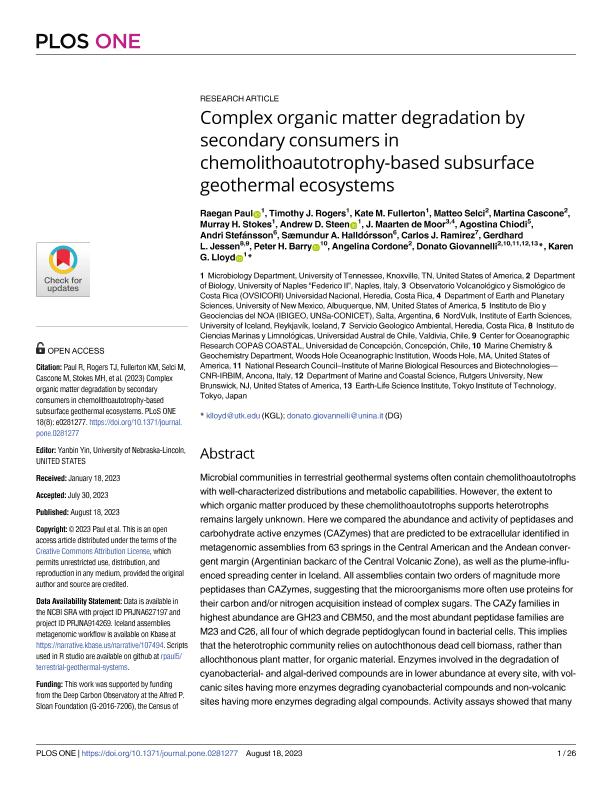Mostrar el registro sencillo del ítem
dc.contributor.author
Paul, Raegan
dc.contributor.author
Rogers, Timothy J.
dc.contributor.author
Fullerton, Kate M.
dc.contributor.author
Selci, Matteo
dc.contributor.author
Cascone, Martina
dc.contributor.author
Stokes, Murray H.
dc.contributor.author
Steen, Andrew D.
dc.contributor.author
de Moor, J. Maarten
dc.contributor.author
Chiodi, Agostina Laura

dc.contributor.author
Stefánsson, Andri
dc.contributor.author
Halldórsson, Sæmundur A.
dc.contributor.author
Ramirez, Carlos J.
dc.contributor.author
Jessen, Gerdhard L.
dc.contributor.author
Barry, Peter H.
dc.contributor.author
Cordone, Angelina
dc.contributor.author
Giovannelli, Donato
dc.contributor.author
Lloyd, Karen G.
dc.date.available
2024-03-13T11:02:14Z
dc.date.issued
2023-08
dc.identifier.citation
Paul, Raegan; Rogers, Timothy J.; Fullerton, Kate M.; Selci, Matteo; Cascone, Martina; et al.; Complex organic matter degradation by secondary consumers in chemolithoautotrophy-based subsurface geothermal ecosystems; Public Library of Science; Plos One; 18; 8-2023; 1-26
dc.identifier.issn
1932-6203
dc.identifier.uri
http://hdl.handle.net/11336/230278
dc.description.abstract
Microbial communities in terrestrial geothermal systems often contain chemolithoautotrophs with well-characterized distributions and metabolic capabilities. However, the extent to which organic matter produced by these chemolithoautotrophs supports heterotrophs remains largely unknown. Here we compared the abundance and activity of peptidases and carbohydrate active enzymes (CAZymes) that are predicted to be extracellular identified in metagenomic assemblies from 63 springs in the Central American and the Andean convergent margin (Argentinian backarc of the Central Volcanic Zone), as well as the plume-influenced spreading center in Iceland. All assemblies contain two orders of magnitude more peptidases than CAZymes, suggesting that the microorganisms more often use proteins for their carbon and/or nitrogen acquisition instead of complex sugars. The CAZy families in highest abundance are GH23 and CBM50, and the most abundant peptidase families are M23 and C26, all four of which degrade peptidoglycan found in bacterial cells. This implies that the heterotrophic community relies on autochthonous dead cell biomass, rather than allochthonous plant matter, for organic material. Enzymes involved in the degradation of cyanobacterial- and algal-derived compounds are in lower abundance at every site, with volcanic sites having more enzymes degrading cyanobacterial compounds and non-volcanic sites having more enzymes degrading algal compounds. Activity assays showed that many of these enzyme classes are active in these samples. High temperature sites (> 80°C) had similar extracellular carbon-degrading enzymes regardless of their province, suggesting a less well-developed population of secondary consumers at these sites, possibly connected with the limited extent of the subsurface biosphere in these high temperature sites. We conclude that in < 80°C springs, chemolithoautotrophic production supports heterotrophs capable of degrading a wide range of organic compounds that do not vary by geological province, even though the taxonomic and respiratory repertoire of chemolithoautotrophs and heterotrophs differ greatly across these regions.
dc.format
application/pdf
dc.language.iso
eng
dc.publisher
Public Library of Science

dc.rights
info:eu-repo/semantics/openAccess
dc.rights.uri
https://creativecommons.org/licenses/by-nc-sa/2.5/ar/
dc.subject
MICROBIAL COMMUNITIES
dc.subject
GEOTHERMAL FLUIDS
dc.subject
CONVERGENT MARGIN
dc.subject
CARBON BUDGET
dc.subject.classification
Geociencias multidisciplinaria

dc.subject.classification
Ciencias de la Tierra y relacionadas con el Medio Ambiente

dc.subject.classification
CIENCIAS NATURALES Y EXACTAS

dc.title
Complex organic matter degradation by secondary consumers in chemolithoautotrophy-based subsurface geothermal ecosystems
dc.type
info:eu-repo/semantics/article
dc.type
info:ar-repo/semantics/artículo
dc.type
info:eu-repo/semantics/publishedVersion
dc.date.updated
2024-03-12T10:59:29Z
dc.journal.volume
18
dc.journal.pagination
1-26
dc.journal.pais
Estados Unidos

dc.description.fil
Fil: Paul, Raegan. University of Tennessee; Estados Unidos
dc.description.fil
Fil: Rogers, Timothy J.. University of Tennessee; Estados Unidos
dc.description.fil
Fil: Fullerton, Kate M.. University of Tennessee; Estados Unidos
dc.description.fil
Fil: Selci, Matteo. Università degli Studi di Napoli Federico II; Italia
dc.description.fil
Fil: Cascone, Martina. Università degli Studi di Napoli Federico II; Italia
dc.description.fil
Fil: Stokes, Murray H.. University of Tennessee; Estados Unidos
dc.description.fil
Fil: Steen, Andrew D.. University of Tennessee; Estados Unidos
dc.description.fil
Fil: de Moor, J. Maarten. University of New Mexico; Estados Unidos
dc.description.fil
Fil: Chiodi, Agostina Laura. Consejo Nacional de Investigaciones Científicas y Técnicas. Centro Científico Tecnológico Conicet - Salta. Instituto de Bio y Geociencias del NOA. Universidad Nacional de Salta. Facultad de Ciencias Naturales. Museo de Ciencias Naturales. Instituto de Bio y Geociencias del NOA; Argentina
dc.description.fil
Fil: Stefánsson, Andri. University of Iceland; Islandia
dc.description.fil
Fil: Halldórsson, Sæmundur A.. University of Iceland; Islandia
dc.description.fil
Fil: Ramirez, Carlos J.. Servicio Geológico Ambiental; Costa Rica
dc.description.fil
Fil: Jessen, Gerdhard L.. Universidad de Concepción; Chile
dc.description.fil
Fil: Barry, Peter H.. No especifíca;
dc.description.fil
Fil: Cordone, Angelina. Università degli Studi di Napoli Federico II; Italia
dc.description.fil
Fil: Giovannelli, Donato. Consiglio Nazionale delle Ricerche; Italia. Università degli Studi di Napoli Federico II; Italia
dc.description.fil
Fil: Lloyd, Karen G.. University of Tennessee; Estados Unidos
dc.journal.title
Plos One

dc.relation.alternativeid
info:eu-repo/semantics/altIdentifier/doi/http://dx.doi.org/10.1371/journal.pone.0281277
Archivos asociados
